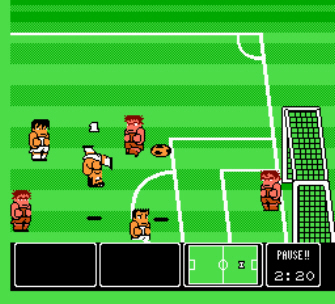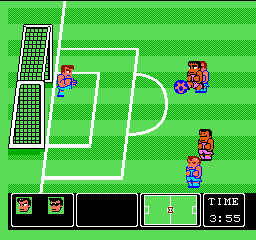 There’s a marvelous yet tragic observation that can be made when looking through the history of sports-based video games. When the genre was confined to a two dimensional, 8- & 16-bit playing space, sports games were often quite successful among a mass audience. Reason being, the way you played a game, like Nintendo World Cup, had nothing to do with the technicalities of that sport itself but rather an enjoyable meta game surrounding the rules of the sport.
There’s a marvelous yet tragic observation that can be made when looking through the history of sports-based video games. When the genre was confined to a two dimensional, 8- & 16-bit playing space, sports games were often quite successful among a mass audience. Reason being, the way you played a game, like Nintendo World Cup, had nothing to do with the technicalities of that sport itself but rather an enjoyable meta game surrounding the rules of the sport.
Punch-Out, for example, has been described as Dance Dance Revolution in the guise of a boxing game, based on the grounds that when you play Punch Out you’re not really boxing. What you’re actually doing is shifting in different directions to avoid incoming blows based on a timed pattern of punches set to your opponent. Once you’ve unlocked the pattern of evasion, defeating the fighter is a cinch. Excite Bike did the same, by forcing you to balance the heat of your engine with the slow/fast moving speed of your vehicle. Sensible Soccer on the other hand is more attuned with fast paced free-style soccer than the real sport, relying on reflex over strategic play. These games stood out as some of the most influential and enjoyed games of their time simply because their gameplay avoided conflicting with the often complicated technicalities of the sport.
Nowadays, sport games are engineered to suit fans and amateur players of the respective sport, whom are familiar with teams, players and rules of the game. You often can’t play these games — at least not very well — without prior understanding of the technicalities of the sport. Realism in the means of authenticity to the sports, its players, leagues and brands has overshadowed the premise of approachable interface and what was once accessible gameplay. The market for these games undoubtedly survives and is sufficiently profitable due to the enthusiast that enjoy the sports, but the overwhelming enthusiasm that these games once garnered by all players alike has largely been lost.
System: NES, Game Boy
Genre: Sport
Released: December 1990 (USA) – later re-released with Super Spike V-Ball and again with Super Mario Bros and Tetris
Players: One – Four Player (with Four Score peripheral)
Developed by: Technos Japan Corp.
Published by: Nintendo
Origin: Japan
 Nintendo World Cup then stands in as a sporting example of how a great soccer (or football, depending on where you hail from) game can be created by deriving the necessary framework for the game from the sport itself, discarding any unnecessary elements in the process. Basically there is enough ‘soccer’ present here to justify the game’s title without too many rules and regulations to spoil the broth.
Nintendo World Cup then stands in as a sporting example of how a great soccer (or football, depending on where you hail from) game can be created by deriving the necessary framework for the game from the sport itself, discarding any unnecessary elements in the process. Basically there is enough ‘soccer’ present here to justify the game’s title without too many rules and regulations to spoil the broth.
In this case, you, of course, play soccer but deal breakers such as off-sides and red cards are noticeably absent. As is the size of your team which is cut down to six players (a goalkeeper, two defenders, a midfielder and two forwards, you play the midfielder). To fill in the absence of these rules, developer Technos Japan placed an emphasis on the rough n’ tough Kunio-kun (see: River City Ransom) play style. Meaning long volley kicks that can stretch almost the entire field, super-shots for goals powered by backflips and diving headers, and lastly plenty of rough tackles.
By removing two of soccer’s most persistently annoying rules (off-sides and red cards) as well as shortening the teams to 6 players, there are no unnecessary distractions for the player to worry about, allowing them to concentrate on who has the ball and how to get it off them. Ironically enough, this in itself reinforces two important elements of the sport which is tackling and marking up your opposition.
Since there are no red cards in the game, tackling is done by shoving your opponent to the ground, giving you the opportunity to whisk the ball away from them. Collision detection of tackles are perfectly precise meaning that marking up (staying close to) the opposition is crucial in order to land the tackle and push the ball in a favorable direction. Land enough tackles and your opponent falls unconscious and is out of play, this can happen to your team mates as well, so be cautious.
Nintendo World Cup NES gameplay video.
Unlike most modern soccer games, in Nintendo World Cup your team is no longer controller completely by one player. Instead you play only as the one (midfielder), shouting out directions to your team mates to pass, tackle or shoot when the ball is out of your possession. This sound fundamentally wrong, but it isn’t. Your AI controlled team mates are reasonable players and so long as you utilize them efficiently there are really no problems to speak of. You can also set attributes to define your team AI before the game and at half time.
While the game is not a one man band like most modern soccer games, you will — particularly leading up to the finals -– need to regularly play your team mates instruments for them. This is allotted for with the previously mentioned volley kicks. Each volley floats in the air long enough for you to run down field and ensure that you can take the tackle if your team mates slips up. Volley kicks are in fact the preferred passing method as any passes to off screen players will naturally be volleys. Short passes are used but often sparingly as they don’t keep pace with the game’s speed unless kept in tight proximity.
The game play in its totality command good reflex and smart thinking from the player, much like the sport itself. As you make your way up through the league, micromanagement starts to kick in and you’ll be leaning on this almost entirely during the final matches. Skill is rewarded through back flipping plays and head butts which create super shots with a good probability of landing a goal, sometimes KO’ing the keeper if he obstructs the ball.
 Being part of the Kunio-kun series, the game features similarly big headed characters painted with angry frowns, slick hairdos and stumpy legs that the series is famous for. Considering the emphasis on tackling, these sprites match the atmosphere that the game brings with it. Furthermore, the slight changes seen among players from different countries represent some amusing ethnic stereotypes.
Being part of the Kunio-kun series, the game features similarly big headed characters painted with angry frowns, slick hairdos and stumpy legs that the series is famous for. Considering the emphasis on tackling, these sprites match the atmosphere that the game brings with it. Furthermore, the slight changes seen among players from different countries represent some amusing ethnic stereotypes.
Being a soccer game, particularly one where the ball is constantly crossing back and forth between each half of the field, the action frequently gets busy making sprite flashes a regular occurrence. It’s not much of a big deal though and the game handles it pretty well on most accounts.
This game also allows for 2-4 players with more than two requiring the NES four score multiplayer controller tap.
Fun Factor: 9
A fast-paced emulation of the sport mixed with the gameplay qualities of the Kunio-kun series. Controls, collision detection and feedback all fit well together creating a tight play experience, which demands increasing effort from the player to master.
Graphics: 9
Crisp colors matched with sharp, punctual character designs add significant punch to the action making characters look enthusiastic about what they’re doing.
Audio: 8
Engaging tunes which intensify the on-field drama, musical presence heightens upon nearing the finals, building greater anticipation within the player. Very appropriately suited to the spirit of the sport. Sound effects bode well into the action.
Ingenuity: 8
Clever inclusions spice up an already solid game, interesting play mechanics.
Replay Value: 8
The World Cup will take an effort to defeat over multiple stretches of play depending on skill. Multiplayer with up to 4 players lengthens the game’s lastability. Overall a very solid length, expect 6-10 hours.
